|
Boston: Starting at the
Beginning
|
Today I can’t cross
Boston Common without thinking of Emerson walking there with Walt
Whitman—nor can I walk up Tremont Street without remembering the Saturday
Club at the Parker House. I wish I knew in which Cambridgeport house Emily
Dickinson spent many a homesick month while consulting a doctor about her
eyes. . . . Have you ever felt something tickle your cheek as you walk down
Brattle Street? I’ll tell you what it is—it’s the ghostly whiskers of some
long-dead transcendentalist.
~Jane Langton, “The Importance of Whiskers”
|
|

|
|
Above: Panoramic photograph of Boston
Common, where Ralph Waldo Emerson and Walt Whitman walked in 1860 as Emerson
tried to persuade Whitman to tone down the sexuality in his poetry. “Each
point of Emerson’s statement was unanswerable, no judge’s charge ever more
complete or convincing,” wrote Whitman. “I could never hear the point
better put – and then I felt down in my soul the clear and unmistakable
conviction to disobey all, and pursue my own way.” (Library of Congress, Prints and
Photographs Division, LC-USZ62-131972 DLC).
|
|
|
Boston has been called “the Athens of America” and “the
Hub of the Solar System.” This is due to its role in the nineteenth century
as “the New World's Hub,” “a center of creativity” that included the
leading Transcendentalists – Ralph Waldo Emerson, Nathaniel Hawthorne,
Henry David Thoreau, Bronson Alcott, Louisa May Alcott, Margaret Fuller,
Elizabeth Palmer Peabody, and many others. To get a feel for this community
and its ongoing legacy in Boston, read Rebecca Harding Davis’s account, “Boston
in the Sixties.”
According
to the Concord Museum, “the birth of American transcendentalism dates from
1836, when a group of people – many of them Unitarian ministers – met in
the Boston home of George Ripley, who eventually started the utopian
community Brook Farm. The Transcendental Club, as it was called, met
periodically, with a fluid roster of members. These men and women lived all
over New England. They conversed by mail, as well as in meetings and
private visits – most frequently in Boston and Concord.”
The
Transcendentalist movement had grown out of a number of religious and philosophical
movements prior to the nineteenth century. Look at Dan’s
take on thinking like a Transcendentalist.
|
|
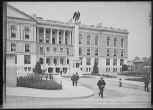
|
The vast majority of Transcendentalist gatherings in
Boston took place on or near Beacon
Hill, a core part of the “City upon the Hill” founded by the Puritans. Read
Linda’s reflections on Beacon Hill.
Left: Beacon Hill Monument in front of Massachusetts State House, Boston,
Massachusetts (Library of Congress, Prints and Photographs Division,
Detroit Publishing Company Collection, LC-D418-30838 DLC).
|
|

|
The burial ground next to King’s
Chapel – the oldest Unitarian church in the United States,
situated in the heart of Beacon Hill – was a key cemetery in the early
Puritan community. As Nathaniel Hawthorne describes Hester Prynne’s grave
at the end of his masterpiece, The Scarlet Letter: “. . . after
many, many years, a new grave was delved, near an old and sunken one, in that
burial-ground beside which King’s Chapel has since been built.” The grave
pictured here bears an engraving of a large letter “A” and is said by
legend to be the inspiration for Hawthorne’s novel.
Left: The “A” Grave, King’s Chapel Cemetery (photo by Anna Hughes).
|
|
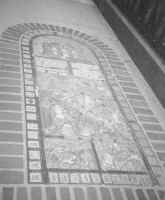
|
Ralph Waldo Emerson and other leading Unitarians and
Transcendentalists attended Boston Public Latin School near Tremont Avenue.
This sidewalk mosaic marks their accomplishments.
Left: Memorial mosaic honoring the Latin School (photo by Anna Hughes).
|
|
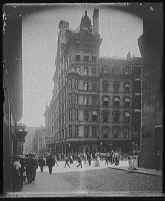
|
One central meeting place for the literary men was the
Parker House, a hotel located at 60 School Street on Beacon Hill. Because
the men met on the last Saturday of each month, their group was known as
the “Saturday Club.” “Their notoriously festive roundtables,” says The
Literary Trail of Greater Boston, “featured readings and intellectual
changes amid endlessly flowing chatter, mirth, food, and spirits.” Be sure
to read Oliver Wendell Holmes’s poem “At the
Saturday Club,” which appeared in The Atlantic Monthly in 1884.
Left: The Parker House, site of the Saturday Club (Library of Congress,
Prints and Photographs Division, Detroit Publishing Company Collection,
LC-D4-68235 DLC).
|
|

|
Another crucial gathering spot for the Boston
Transcendentalists was the Old Corner Bookstore, just down School Street at
the corner of Washington Street. Originally the site of a home built by
Puritan dissenter Anne Hutchinson and her husband, this location became
central to the Transcendentalist movement. Here, in the first brick
building in Boston, William D. Ticknor and James T. Fields “revolutionized
American book publishing between 1845 and 1865.” Together, Ticknor and
Fields earned “worldwide renown as a well-stocked shop, a prominent
publishing house, and a magnet for the literary world.” Today, the Houghton
Mifflin Publishing Company is the firm that remains generations
later.
Left: Old Corner Bookstore (Library of Congress, Prints and Photographs
Division, Detroit Publishing Company Collection, LC-D4-11969 DLC).
|
|

|
Walking four blocks down
Washington Street, a visitor will soon come to 13-15 West Street, where a
plaque indicates that this was at one time the location of the Elizabeth Palmer Peabody Book Shop. “The store she ran
at the front of her home on West Street,” says The Literary Trail,
“became a gathering place, in part because she stocked many foreign books
and periodicals.” Here, Peabody published Thoreau’s famous essay “Civil
Disobedience,” helped to publish the Transcendentalist magazine, The
Dial, and hosted weddings for her sister Mary (to education reformer
Horace Mann) and her sister Sophia (to Nathaniel Hawthorne). Also keenly
important here were the “Conversations” held by Margaret Fuller. During these “Conversations,” women in
the larger Transcendentalist community gathered to discuss issues of
relevance to them, and the seeds of the Women's Rights Movement were
planted. Read
Tiffany’s reflections on Margaret Fuller.
Coming back almost to the Parker House, the literary
visitor will spot Tremont Temple, where Bronson Alcott held his famed Temple School, at 88 Tremont Street.
Left: Tremont Temple (Library of Congress, Prints and Photographs
Division, Detroit Publishing Company Collection, LC-D4-11968 DLC).
|
|
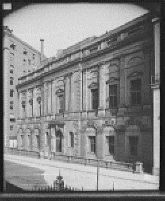
|
Just around the corner, the visitor will find the Boston
Athenaeum at 10-1/2 Beacon Street. Many Transcendentalist writers and intellectuals
conducted research and immersed themselves in their writing at this major
library and research facility. Ralph Waldo Emerson was known, says The
Literary Trail of Greater Boston, to “take the train from his home in
Concord, then visit the Old Corner Bookstore and
the Athenaeum before dining at the Parker House.”
Left: The Boston Athenaeum (Library of Congress, Prints and Photographs
Division, Detroit Publishing Company Collection, LC-D4-19615 DLC).
|
|

|
Walking the streets of Beacon Hill, the literary traveler
should also stop at 4 Pinckney Street, where Henry David Thoreau once
lived; 15 Pinckney Street, one of the places where Elizabeth Palmer Peabody
started kindergarten classes; and 20 Pinckney Street, 43 Pinckney Street,
and 81 Pinckney Street, all locations where the Alcotts rented rooms.
The last home for Bronson Alcott and his daughter Louisa
May Alcott was just around the corner at 10 Louisburg Square. The father
and daughter lived here from 1885 to 1888, when they died within two days
of each other.
Left: Louisburg Square, last home of Bronson Alcott and Louisa May Alcott
(photo by Anna Hughes).
|
|
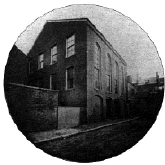
|
On Beacon Hill’s north slope, the African American
community was struggling to put Transcendentalist notions into practice as
well. Boston’s Black
Heritage Trail provides a wealth of information for exploring this part
of the city’s history. The African
Meeting House, at 8 Smith Street, became a central gathering place for
leaders of the abolitionist movement. Here, William Lloyd Garrison, the
white leader of the movement, rallied many Bostonians to the cause, and
Frederick Douglass spoke here, as well as at Faneuil Hall and Tremont
Temple. Douglass also worked at the African Meeting House to recruit
African American soldiers for the 54th Massachusetts volunteers. The history of
the Meeting House provides excellent insight into the emergence of the
abolitionist movement.
Left: African Meeting House.
|
|

|
Frederick Douglass and other abolitionists recruited
soldiers for an all-black regiment as part of the Union forces for the
Civil War. The Robert Gould Shaw and 54th Regiment Memorial marks their contributions and is located on Beacon
Street.
Left: Sarah Alouf and Cat Hall in front of Civil War (photo by Anna Hughes).
|
“American
Transcendentalism: An Online Travel Guide” was produced by students in ENGL
446, American Transcendentalism, and ENGL 447, American Literature and the
Prominence of Place: A Travel Practicum. These courses were team-taught in
the Department of English at Shepherd College (now
Shepherd University), Shepherdstown, West Virginia, in Spring 2002 by Dr.
Patricia Dwyer and Dr. Linda Tate. For more information on the course and
the web project, visit “About This
Site.” ©
2003 Linda Tate.
|





